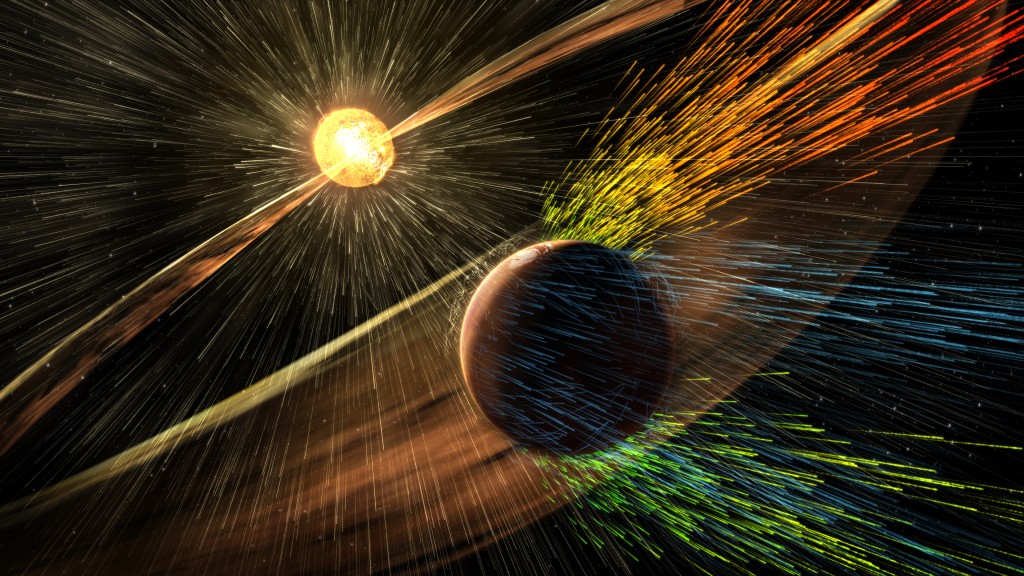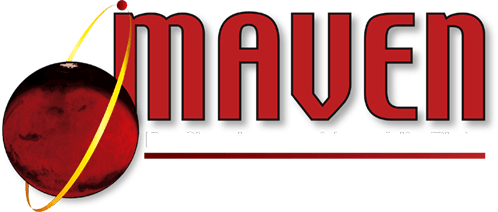
NASA’s MAVEN (Mars Atmosphere and Volatile Evolution) mission is the only asset currently at Mars that is able to observe the Sun’s activity as well as the simultaneous response of the Martian atmosphere to its influences. In December 2022, MAVEN observed a dramatic and unexpected “disappearance” of the solar wind, during which its density dropped significantly.
Without the pressure of the solar wind hitting the planet, the Martian magnetosphere and ionosphere expanded by thousands of kilometers. This remarkable event allowed scientists to get a look at what the Martian atmosphere would look like if it were next to a less “windy” star. Below is a guide to research being presented at the American Geophysical Union 2023 meeting related to this event, which was the first ever observed by MAVEN in its almost 10 years at Mars.
Media contacts:
Willow Reed, MAVEN Communications Lead, LASP/CU Boulder,
willow.reed@lasp.colorado.edu
Nancy N Jones, Senior Communications Manager, NASA GSFC,
nancy.n.jones@nasa.gov
AGU Media Roundtable:
Disappearing solar wind: New results from the NASA MAVEN Mission
Panelists:
Shannon Curry, Jasper Halekas, Skylar Shaver, Yingjuan Ma
Monday, December 11, 15:30-16:15 | AGU Press Center
AGU Presentations:
The following are listed in chronological order, and all times are PST.
Monday, December 11, 9:00-9:10
Simulation Based Inference for Parameter Estimation of the Solar Wind in Extreme Conditions: A Case Study at Mars
Abigail Azari*, University of British Columbia (formerly Space Science Laboratory - UC Berkeley)
This presentation will discuss an application of machine learning to derive physical parameters from physics-based models and data using the disappearing solar wind event as a case study. Specifically, Azari et. al. are estimating parameters of the upstream solar wind during the event in which there were no in situ measurements, allowing a more holistic understanding of the event.
Monday, December 11, 17:05-17:15
Revealing the origin of the December 2022 disappearing solar wind event
Ryan Dewey, University of Michigan
This presentation explores the in situ observations of a disappearing solar wind event from four spacecraft: Solar Orbiter, STEREO-A, Wind, and MAVEN. Combined, they witnessed the event in interplanetary space, near Earth and at Mars. These multi-point observations allow Dewey et. al. to understand the evolution of the solar wind during this remarkable event.
Tuesday, December 12, 16:45-16:55
The Martian Ionospheric Response to the Co-rotating Interaction Region that caused the Disappearing Solar Wind Event in December 2022
Skylar Shaver*, Laboratory for Atmospheric and Space Physics - CU Boulder
This presentation examines the co-rotating interaction region (CIR) and trailing rarefaction region, which caused the “disappearance” of solar wind, and its interaction at Mars. As the CIR passed by the planet, it presented a great opportunity to study the way solar wind at different speeds, densities, and magnetic orientations affect the Martian atmosphere.
Thursday, December 14, 11:22-11:33
Multi-fluid MHD study of the extremely low solar wind density event observed by MAVEN on December 26, 2022
Yingjuan Ma, University of California Los Angeles
Using the latest multi-fluid MHD model developed for Mars (Ma et al., 2019), this presentation examines the extremely low solar wind density event observed by MAVEN. The results indicate the near-Mars plasma environment was altered substantially in response to the sharp decrease of the solar wind density.
Thursday, December 14, 14:10-18:30
Disappearing Solar Wind at Mars: Changes in the Mars-Solar Wind Interaction
Christopher Fowler, West Virginia University
Utilizing in-situ plasma measurements made by the MAVEN mission, this presentation is focused on the transformation of Mars’ ionosphere during the disappearing solar wind event. Specifically, Fowler et. al. will discuss the unmagnetized conditions of Mars’ ionosphere during the event and its comparison to the commonly reported unmagnetized ionospheric state at Venus.
Friday, December 15, 9:25-9:35
The Day the Solar Wind Disappeared at Mars
Jasper Halekas*, University of Iowa
*Co-organizer of the MAVEN team’s disappearing solar wind working group

